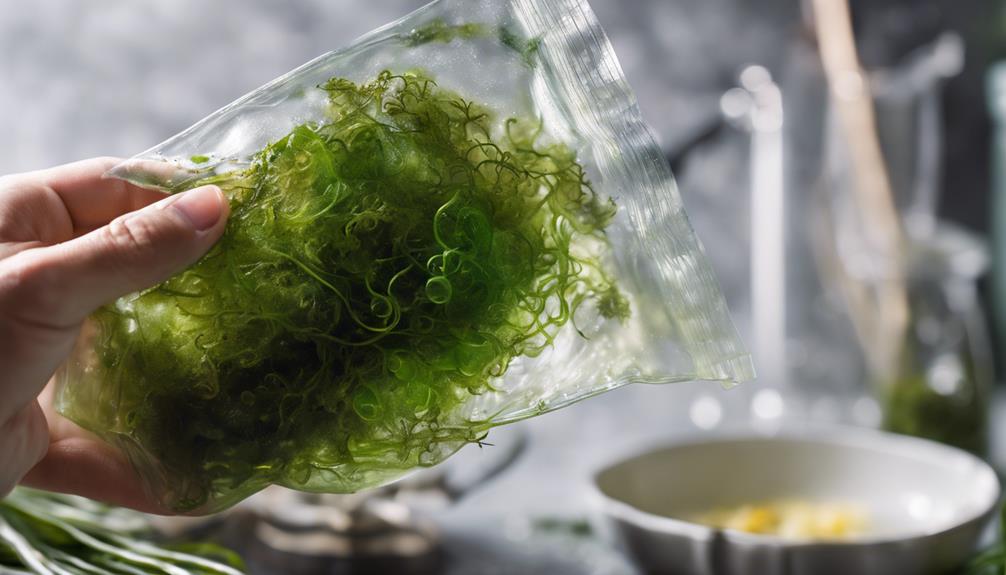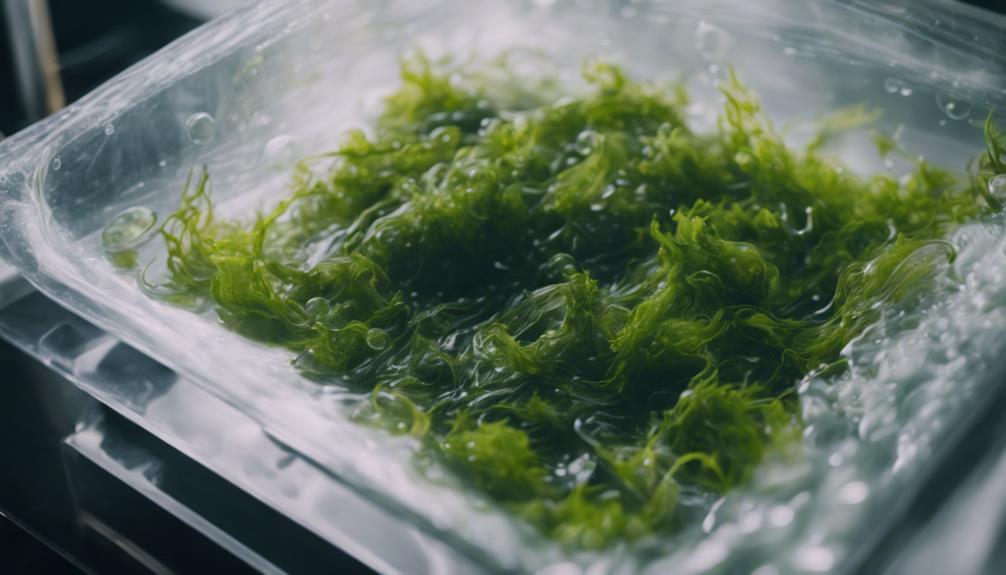Sous Vide Seaweed Infusion
Immerse yourself in the cooking technique of sous vide seaweed infusion for a culinary adventure. Seal seaweed in airtight bags with liquids or oils for steady, controlled cooking. Enhance seaweed's natural flavors and nutrients through precise temperature regulation. Experiment with various types of seaweed to discover distinct tastes and textures. Elevate dishes with the umami-rich essence of seaweed. Discover how sous vide brings out the best in seaweed, revealing a world of gastronomic possibilities.
What You Will Learn Here
- Sous vide seaweed infusion extracts flavors gently.
- Vacuum-sealed bags prevent flavor loss during infusion.
- Infuse seaweed at low temperatures for optimal results.
- Customize infusion time based on desired intensity.
- Experiment with different seaweed types for diverse flavor profiles.
Seaweed's Culinary Evolution

You'll explore Seaweed's Flavor Profiles, examining how its unique taste can enhance culinary creations.
Modern cuisine has been incorporating seaweed in innovative ways, pushing the boundaries of traditional flavors.
Additionally, you'll learn about the various health benefits that seaweed offers, making it not only a flavorful but also a nutritious ingredient.
Seaweed's Flavor Profiles
Seaweed's flavor profiles have undergone a remarkable evolution in the culinary world, showcasing a diverse range of tastes and textures that have captivated chefs and food enthusiasts alike. This versatile ingredient is known for its umami-rich properties, adding depth and complexity to dishes.
Different types of seaweed offer distinct umami flavor profiles; for example, nori provides a savory and slightly sweet taste, while kombu offers a more intense umami note. Wakame brings a mild sweetness and a tender texture, ideal for salads and soups.
Seaweed in Modern Cuisine
In modern culinary practices, seaweed has experienced a significant evolution, transforming from a traditional ingredient to a versatile and highly sought-after element in contemporary cuisine. Chefs are exploring innovative ways to incorporate seaweed into dishes, such as experimenting with seaweed cocktail pairings that enhance both the flavor and visual appeal of beverages.
Additionally, the use of seaweed in spa treatments has gained popularity due to its various beneficial properties for the skin. The rich umami flavor and nutrient density of seaweed make it a desirable ingredient for both savory and sweet dishes, adding depth and complexity to culinary creations.
As modern cuisine continues to push boundaries, seaweed's adaptability and unique characteristics position it as a staple in the culinary world.
Seaweed's Health Benefits
Exploring the culinary evolution of seaweed reveals a plethora of health benefits that contribute to its rising popularity in modern cuisine. Seaweed is a nutritional powerhouse, packed with essential vitamins and minerals such as iodine, calcium, iron, and magnesium. These seaweed nutrients support various bodily functions, including thyroid health, bone strength, and energy production.
Additionally, seaweed is rich in antioxidants, which help combat oxidative stress and inflammation in the body. For individuals looking to boost their nutrient intake, seaweed supplements are a convenient option to incorporate these benefits into their diet. The growing recognition of seaweed's health advantages has led to its integration into diverse dishes, making it a versatile and beneficial ingredient in contemporary cooking.
Seaweed Selection Guide

For best results in your sous vide seaweed infusion, carefully select the appropriate type of seaweed based on its flavor profile and texture characteristics. When choosing seaweed for your infusion, consider the following factors:
- Seaweed types: Different types of seaweed offer varying flavors and textures. Some popular choices include kombu, wakame, nori, and dulse. Each type brings a unique taste and mouthfeel to your infusion.
- Preservation: Opt for seaweed that's fresh or properly dried to maintain its quality. Avoid seaweed that appears discolored, slimy, or has a strong fishy odor, as these are signs of spoilage.
- Seaweed flavors: Consider the flavor profile of the seaweed and how it will complement the other ingredients in your infusion. Some seaweeds have a more umami-rich taste, while others are milder or brinier.
- Pairing: Think about how the seaweed will pair with the other components of your dish. Certain seaweeds may enhance seafood-based infusions, while others work well with vegetable or meat-based concoctions.
Seaweed-Inspired Dishes
Explore the culinary possibilities with seaweed by incorporating it into dishes like the savory seaweed sushi roll, seaweed ramen bowl, and seaweed-infused ice cream.
These creations offer a unique umami flavor profile and a nutritional boost from the seaweed's rich mineral content.
Experimenting with seaweed-inspired dishes can add depth and complexity to your culinary repertoire.
Savory Seaweed Sushi Roll
To create a flavorful Savory Seaweed Sushi Roll, incorporate umami-rich seaweed into the ingredients for a culinary experience that enhances the traditional sushi taste profile. Seaweed brings a unique marine essence that complements the delicate flavors of sushi rice and fillings. Here are some tips to elevate your sushi roll:
- Use a mix of nori and dulse seaweed for depth of flavor.
- Experiment with adding wakame seaweed to the filling for a hint of brininess.
- Try sprinkling Seaweed seasoning blends on top for an extra burst of umami.
- Garnish your roll with thinly sliced cucumbers and radishes for a invigorating crunch.
Seaweed Ramen Bowl
Consider incorporating a variety of seaweed types to enhance the umami profile of your Seaweed Ramen Bowl. When creating your bowl, explore different seaweed noodle alternatives to add texture and flavor complexity.
Additionally, experiment with various seaweed broth variations to achieve a rich and savory base for your ramen. To elevate your Seaweed Ramen Bowl further, try incorporating crispy seaweed toppings for a contrast in texture. Remember to balance the flavors carefully, ensuring that the seaweed elements complement each other harmoniously in every spoonful.
- Mix seaweed noodles for varied textures.
- Experiment with kombu-based broths for a traditional flavor profile.
- Try wakame-infused broths for a lighter, more delicate taste.
- Garnish with nori strips for an authentic touch.
Seaweed-Infused Ice Cream
Immerse yourself in the world of Seaweed-Infused Ice Cream, a captivating addition to your dessert menu that puts a unique spin on traditional frozen treats. Seaweed brings a subtle oceanic flavor and a hint of umami to the creamy sweetness of ice cream, creating a harmonious balance of tastes. This avant-garde dessert isn't only delicious but also offers a range of health benefits associated with seaweed consumption. Delve into the world of Seaweed-Infused Ice Cream and tantalize your taste buds with a treat like no other.
Explore the invigorating and nutritious option of Seaweed smoothie bowls.
Indulge in the potential Seaweed skincare benefits for a radiant glow.
Experiment with incorporating seaweed into various dessert recipes for a unique culinary experience.
Discover the versatility of seaweed as an ingredient that can elevate your dishes.
Seaweed Preservation Techniques
When preserving seaweed, you can utilize different techniques such as drying, pickling in vinegar, and freezing to extend its shelf life and maintain its flavor and texture.
Drying seaweed removes moisture, preventing bacterial growth; pickling in vinegar adds a tangy flavor and acidity while preserving the seaweed; freezing seaweed is a simple method for long-term storage, locking in freshness.
Each technique offers unique benefits, catering to individual preferences and culinary needs.
Drying Seaweed for Preservation
To effectively preserve seaweed, drying it using proper techniques is essential. Two common methods for drying seaweed are the air drying method and the sun drying process. The air drying method involves hanging the seaweed in a well-ventilated area until it is completely dry. On the other hand, the sun drying process accelerates the dehydration of seaweed by placing it under direct sunlight. Vacuum sealing the dried seaweed helps maintain its freshness for a longer period. Below is a table summarizing these drying techniques:
| Drying Method | Description | Advantages |
|---|---|---|
| Air Drying | Hanging seaweed in a ventilated area | Natural, cost-effective |
| Sun Drying | Placing seaweed under direct sunlight | Faster drying process |
Pickling Seaweed in Vinegar
Pickling seaweed in vinegar is a traditional method utilized for preserving seaweed while enhancing its flavor profile. Seaweed pickling involves submerging fresh seaweed in a vinegar infusion containing salt, sugar, and spices.
The vinegar acts as a natural preservative, extending the shelf life of the seaweed while imparting a tangy and acidic taste. The pickling process also helps to soften the seaweed's texture, making it more palatable for consumption.
To pickle seaweed effectively, make sure that the vinegar solution completely covers the seaweed and store it in a cool, dark place for best preservation. Experiment with different vinegar infusions and seasoning combinations to create unique and flavorful pickled seaweed variations that can be enjoyed on their own or as a tasty addition to dishes.
Freezing Seaweed for Storage
For optimal storage of seaweed, consider freezing it as a preservation technique. Seaweed storage can be enhanced by utilizing freezing techniques that maintain the seaweed's freshness and nutritional value.
When freezing seaweed, make sure it's thoroughly cleaned and dried to prevent ice crystal formation and maintain quality. Divide the seaweed into manageable portions before freezing, either whole or chopped, to facilitate easy use later on.
Seal the seaweed in airtight containers or freezer bags, making certain all air is removed to prevent freezer burn. Label containers with the date of freezing to track freshness.
Final Thoughts
With all the components carefully infused, the Sous Vide Seaweed recipe demonstrates a harmonious blend of flavors and textures. The method of sous vide cooking has allowed for the exploration of unique flavor combinations, enhancing the seaweed's natural umami taste and creating a dish that is both nutritious and delicious.
Below is a table highlighting the benefits of sous vide cooking in the context of the Seaweed Infusion recipe:
| Benefits of Sous Vide Cooking | Description |
|---|---|
| Precise Temperature Control | Guarantees even cooking and retention of nutrients |
| Enhanced Flavor | Ingredients are infused with rich flavors |
| Tender Texture | Results in a perfectly tender seaweed |
Frequently Asked Questions
Can Any Type of Seaweed Be Used for Infusion?
You can use various seaweed varieties for infusion, each offering unique tastes. Experiment with different types like kombu, nori, or wakame to discover your favorite flavors. Explore infusion techniques and recipes for exciting culinary adventures.
What Are the Health Benefits of Seaweed Infusion?
When considering seaweed infusion, you'll discover a plethora of nutritional benefits. Seaweed is rich in vitamins, minerals, and antioxidants. Its umami flavor profile enhances dishes, making it a versatile ingredient in various culinary applications, aligning with current wellness trends.
How Long Does the Infusion Process Take?
To get the best seaweed infusion, consider the infusion duration and the types of seaweed. Flavor extraction may vary depending on the seaweed type used. The infusion process typically takes between 1 to 4 hours for best results.
Can Seaweed Infusion Be Used in Sweet Dishes?
Sure, seaweed infusion can definitely be used in sweet dishes. It adds a unique umami flavor and creates an unexpected pairing of sweet meets savory. Experimenting with this culinary fusion can lead to exciting and innovative taste experiences.
Are There Any Safety Concerns With Seaweed Infusion?
When contemplating seaweed consumption, it's important to be mindful of mercury levels and potential allergies. Cross-contamination is also a concern. Guarantee safety by sourcing quality seaweed and monitoring intake for a balanced diet.
Conclusion
Overall, sous vide seaweed infusion offers a unique and innovative way to incorporate the flavors and nutrients of seaweed into culinary creations. By carefully selecting the right type of seaweed and using precise techniques for preservation, chefs can elevate their dishes with a taste of the sea.
Experimenting with different seaweed-inspired dishes can lead to a deeper understanding and appreciation of this versatile ingredient. Consider exploring the world of seaweed in your next culinary endeavor.











